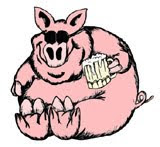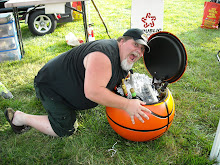While waiting my turn at Giunta's Prime Shop in the Reading Terminal Market, I was watching fresh cut racks of beef ribs being placed in the display window. I started thinking of the ways I would love to grill or smoke them then it hit me... corned beef ribs. When it was my turn to order, instead of my normal $50 packer brisket, I bought 4 racks of fresh beef ribs - saving about $26. I already had my brine done so I couldn't wait to get them going.
Here is the brine I used on the ribs:
2 cups turbinado sugar
2 1/2 cups sea salt
12 juniper berries
12 whole cloves
12 black pepper corns
3 bay leaves
3 sprigs of thyme
1 Cinnamon stick
1 piece mace crushed
1 TBS red pepper flakes
1 dried cayenne pepper crushed seeds and all
4 1/2 quarts water
2 cups turbinado sugar
2 1/2 cups sea salt
12 juniper berries
12 whole cloves
12 black pepper corns
3 bay leaves
3 sprigs of thyme
1 Cinnamon stick
1 piece mace crushed
1 TBS red pepper flakes
1 dried cayenne pepper crushed seeds and all
4 1/2 quarts water
Bring every thing to a boil then reduce temp and simmer for 20 minutes - let cool and strain into brining container. I do not use saltpeter or any other curing agents in my brine so this whole process must be done under proper refrigerated condititons. Also the final product will not have that pink color people may be accustomed to seeing in corned beef but it does not lack any of the flavor.
A good rule to follow when brining is 5 days per 1 inch thickness of meat. I cut the racks of ribs into 4 and 5 rib sections. There was a lot of fat on the ribs that a normal person may trim off before brining. With me the fat stays on, I happen to like how the fat really absorbs the flavor of the brine - personal choice. I left them brine for 8 days before taking them out and rinsing them off.


I cooked the ribs the same way that I like to do the corned beef brisket, in a pot with just enough water to cover meat, some black pepper corns, red pepper flakes for some more heat, and about 4 crushed garlic cloves. Bring this to a boil then reduce and simmer for 3 hrs.
I finished the ribs by sprinkling on some of my BBQ brisket pepper rub and hit them under the broiler for a minute or 2 to firm them up. The meat just came right off the bone, it was juicy and had that intense corned beef flavor that I love. The addition of the cayenne pepper gave it a nice spice and heat. It was great to be able to pick it up using the exposed bone as a handle. I paired it with my homemade colcannon (mashed potatoes, cabbage and green onion). They definitely met my expectation and satisfied my caveman-like carnivore cravings.
Next batch of ribs I brine are going to be finished on the smoker, cooked low and slow with some hickory and cherry wood... Pastrami on a Stick?!
Cheers!

















